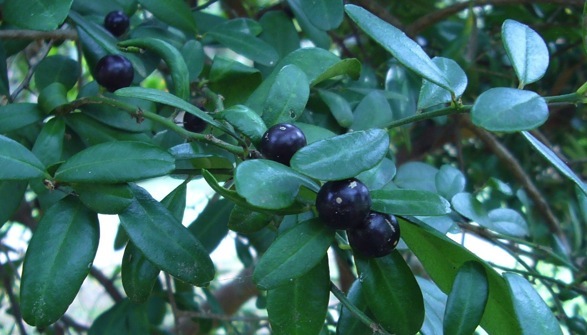Atalantia buxifolia: Wine-Cake Thorn
The Chinese Box-Orange is one of my botanical mysteries. For a long time I thought it was an edible but…
If you Google the Atalantia buxifolia (formerly Severinia buxifolia) you will find several credentialed sites and publications with degreed authors saying the tree has an edible part. That makes sense. It’s in the greater citrus family. Most if not almost all the experts say the leaves are used to make a yeast roll in Chinese cooking. At least one book says the berries are used to make the yeast rolls. So I decided to ask some experts. I have a friend who’s Chinese and owns a Chinese restaurant and has several Chinese chefs. They have no idea. The leaves may be fermented, the berries may be fermented, or they may use one or the other totally differently. Or, it is not edible at all.
The problem might be language. The characters for the plant are similar to the characters for the spring roll, or so a linguist told me. Therein lies the problem which is the assumption based on characters (by linguists) that the plant has something to do with the spring roll. But in the culinary world it does not appear to be used at all. Instead of guilt by associate it is edibility by association. Thus I cannot recommend it as an edible. If someone has some good evidence otherwise I’d like to hear from you.
The Chinese box-orange is native to Southeast Asia, Taiwan and southern China. In Cantonese know it as Tsau Ping Lak because they use some part of it to make a yeast cake. So, how did it get from there to here? It’s resistant to many of the diseases that attack citrus so it makes good root stock. It is also an ornamental. You’ll find it where citrus grows. A close relative, A. monophylla, has a lot of medicinal uses in India including using berry oil for relief of rheumatism and paralysis, a root preparation as an antiseptic and stimulant, and the leaves are used against snake bite. A. buxifolia has two close look alikes, the Japanese Box (Buxus microphylla var. japonica) except the Buxus has no thorns, and the Bumelia retusa, which looks very similar but has red hair on the bottom of young leaves and not all the leaves are notched at the end.
Atalantia (at-uh-LAN-tee-uh) is from Greek mythology. She was daughter of King Schoeneus of Scyros and one of the Hesperides, the nymphs who guarded the garden where grew the golden apples Gaea gave to Hera as a wedding gift. Buxifolia (buks-siff-FOH-lee-uh) means foliage like the box wood which is a Buxus (BUK-sus) the Roman name for the Box Wood. The Chinese Box-Orange is still called Severinia buxifolia (sev-ver-RIN-nee-uh buks-siff-FOH-lee-uh) which honored M. A. Severino (1580-1656) an anatomy lecturer at Naples.
Green Deane’s “Itemized” Plant Profile
IDENTIFICATION:
A low growing, irregular spreading shrub that grows to about four feet high and around. It’s dense and compact, with small, glossy, rounded dark green leaves about a half inch across and an inch long, indented at the tip. Young leaves are bronze. Older leaves are covered with glans on the underside. When crushed the leaf smells of oranges. Flowers are clusters of small, white, fragrant citrus-like flowers that appear near the end of the branch. Blooms all year. Fruit is a small black 1/4 inch berry, one or two seeds.


